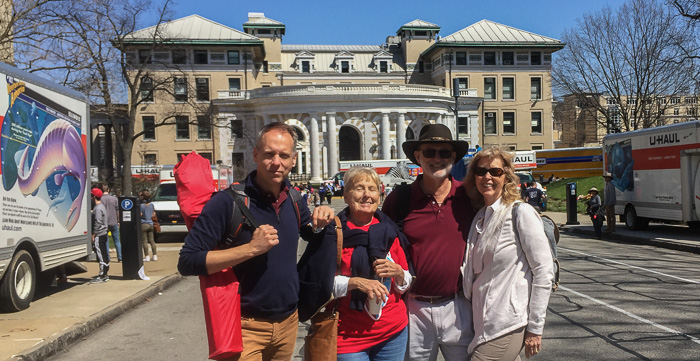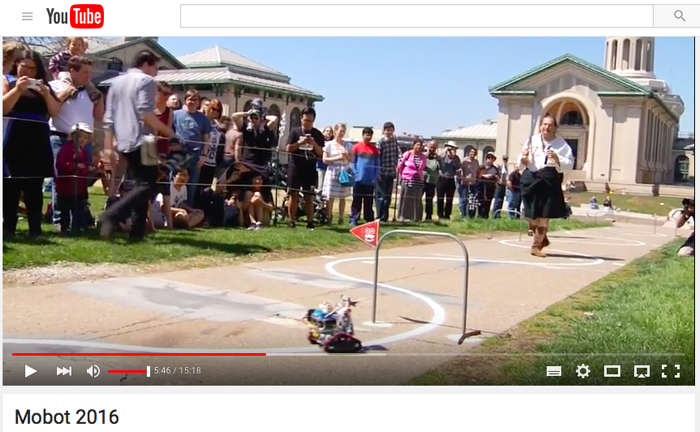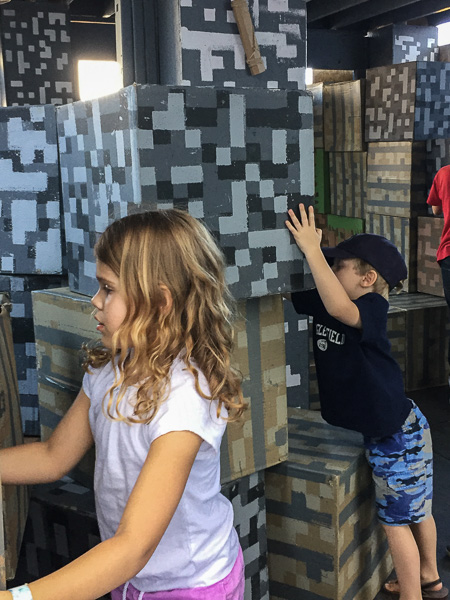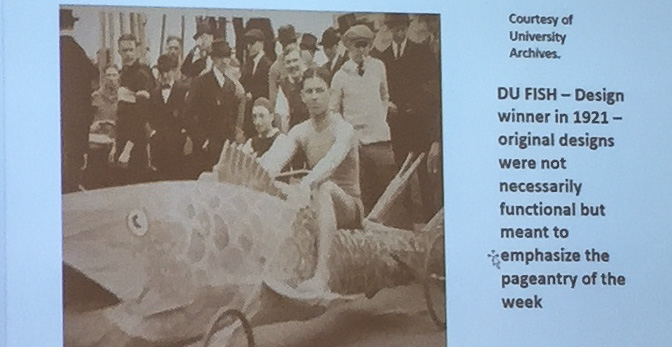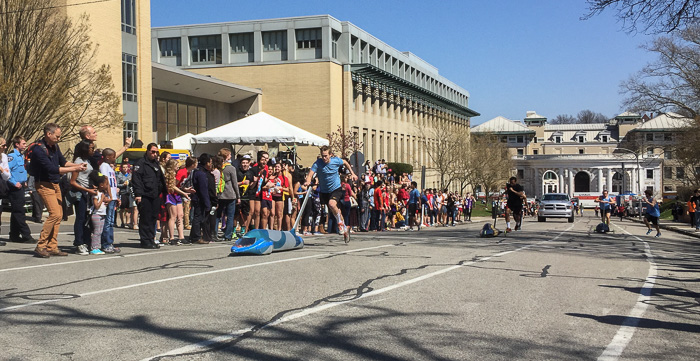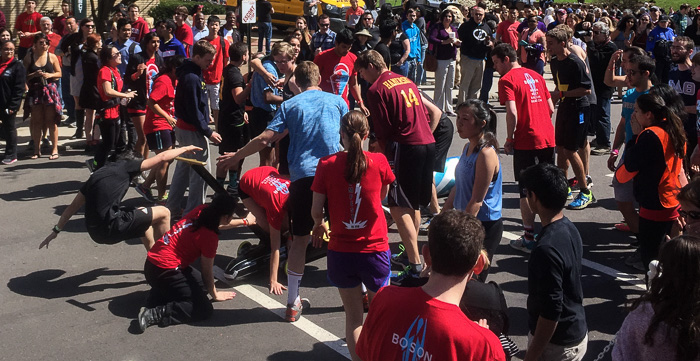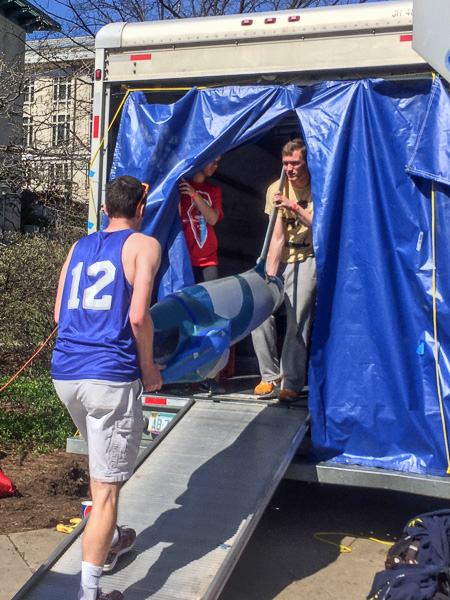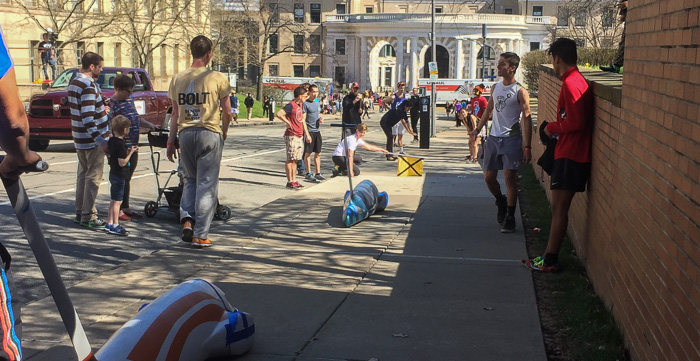Carnegie Mellon’s Super-Cool Spring Carnival Traditions: Mobot, Booth and Buggy
Our older son Jacob became a Carnegie Mellon Tartan in August of 2013 and while we have visited the school many times, this April marked our first time at CMU’s Spring Carnival. Jacob has been deeply involved with Carnival since his freshman year and it was high time we experienced it first hand. I’m so glad we went! It’s an incredible tradition that’s still going strong after 100+ years. I wrote about our trip - and Jacob specifically - in another blog post. This article focuses more generally on Spring Carnival and its unique competitions.
Let’s start with a very brief history of Carnegie Mellon: In 1900 Andrew Carnegie gave $1 million to found a technical institute in Pittsburgh, The Carnegie Technical Schools, where men and women could learn practical skills. Of course men and women were segregated, and women attended the Margaret Morrison Carnegie College. The Carnegie Institute of Technology (Tech) started granting four-year degrees in 1912, and become Carnegie Mellon University 55 years later when Tech merged with the Mellon Institute of Industrial Research in 1967. In 1973, Margaret Morrison closed and “women joined their male peers in classrooms and dorms.”
According to this article, CMU’s Spring Carnival traces its roots back to Tech’s 1915 “Qualification Day” when freshman plebes were officially accepted. In the intervening 102 years, Carnival has grown and morphed into a spring extravaganza offering alumni reunion events, speakers, Scotch ’n Soda performances, outdoor music concerts, carnival rides, food booths, and Midway games. Some traditions have come and gone including Campus Week, Campus Queen, Canoe Tilt, Plank Jousting, and Gazorching (a combination of shot put and water balloon launching), but others have stood the test of time.
Three competitive events have become hallmarks of Carnival and typify the unique education offered at Carnegie Mellon and showcase its students’ creativity, skill, and hard work: Mobot (in its 22nd year), Booth (since the 1950s) and Buggy (since 1920). To witness a Spring Carnival is to see the school’s motto, “My heart is in the work”, come to life.
Mobot
I admit I don’t know much about this event (Jacob’s never competed) but in a nutshell, “Mobot” stands for “MObile roBOT”, and the Mobot competition is an annual race founded in 1994 where each entrant designs and builds an autonomous robot with “perception, action, and reasoning capabilities” that can “perceive features of the world and…navigate towards the achievement of its goals.” What are its goals? Well, the race course consists of a series of gates placed periodically along a wavy white line painted on a sidewalk in front of Wean Hall. Mobots must pass through the numbered gates in order, and maintain control through two downhill sections.
I was hoping to catch the race this year, but got tied up at Buggy and missed the whole shebang. Still, we passed the course many times since the competition is held outdoors. I was surprised to find that the single painted line eventually splits into multiple paths and the mobot must choose the correct line to successfully reach each gate. Vehicles must be fully autonomous; teams are disqualified if their mobot is interacted with in any way.
The technical know-how for this whole operation is way beyond me (understatement of the century) but right in the wheelhouse for CMU students. Although I missed the live event, this video gives a taste. If you don’t want to watch the whole thing, start at 4:14 for the first mobot to make it through a bunch of gates; alas it gets confused at 7:06 at the branching lines and fails, but the team tries the course again and at 10:47 there’s much rejoicing when the mobot chooses correctly. Watching even part of the video reveals that Mobot is a challenging and often frustrating competition, but the $1,000 1st place prize is a pretty sweet goal to strive for. Of course it’s not about the money, but the experience and knowledge gained… :)
Booth
Spring Carnival has all the trappings of a small-town fair with spinny rides, bouncy houses, and tempting food (fried oreos!), but unlike traditional carnivals, the Midway booths at CMU are original, free-standing structures that are designed and constructed by student groups based on an over-arching theme. They’re also free and open to the public! Within this year’s “Game Night” theme, sororities, fraternities, and independent groups designed booths that were larger-than-life versions of Mouse Trap, Legos, Minecraft, Skyrim, Luigi’s Mansion, Angry Birds, Clue, and more.
The 2016 Carnival sported 25 booths in all ranging from “blitz” (half-size single level structures) up to two-story buildings with staircases and fully-wired electric lighting. Carnival officially begins when the Midway opens at 3pm on a Thursday afternoon, and though it’s not immediately obvious to the untrained eye, scores of bleary-eyed students wandering about hint at the months of hard work it takes to design and build a booth.
Booth themes are chosen in the fall and though construction and design can occur throughout the winter and early spring, things seem to ramp up markedly in late March and April. The tempest is unleashed on the Friday before Carnival at “Move On” when groups are allowed to bring equipment and pre-fab pieces to the lot and begin construction. The madness continues throughout “Build Week” when groups work furiously to not only complete their booth on time, but to create a structure that provides a unique experience for the hundreds of visitors who will pass through. Booths are judged on a variety of criteria with prizes awarded on Saturday afternoon, the last day of Carnival. Prizes are clearly coveted and provide well-earned recognition for the blood, sweat and tears shed - hopefully not much blood, but I’ve heard that exhaustion and looming deadlines lead to many tears, especially in the 24 hours or so before opening! It’s no wonder considering students are actually students and still have classes, papers and projects to fit in around Carnival mania.
A booth may be born of lumber and wiring but it requires serious creative design to be fully realized; one look at Fringe’s awesome Lego people and you get the idea. I love the fact that Booth brings myriad talents together to create temporary marvels. The booths vary in quality of course, and all look a bit ragged around the edges by Saturday afternoon; it’s tough to withstand 2 1/2 days of Carnival-goers tromping through, playing games, and often messing with design features. Incredibly, what took months to build (including one very intense week) takes just eight hours to dismantle. Midway closes at 9pm Saturday, groups start tear-down at 9am Sunday, and finish by 5pm the same day. So sad in a way, but though the structures are short-lived, the memories endure.
Buggy
While Mobot and Booth are both super-cool, Buggy absolutely blows my mind. Technically, the competition is called Sweepstakes and originated in 1920 with “a conglomeration of rain barrels, orange crates, and ash cans with wheels” competing in a simple race with one pusher and one driver.
The rules and course changed quite a bit over the next eight years but the race seen today remains largely the same as the one run in 1928, albeit with safety modifications and huge technical advances. Today’s buggies are sleek, 5-foot long pods with a slim push bar extending off the rear; much improved from the Soap Box Derby style of year’s past. Check out this video for a brief overview of buggy styles from 1920 to present. Though early designs may have lacked aerodynamics, creativity abounded - love the bathtub buggy!
Buggy is often described as a relay race where the buggy is the baton. It’s important to note that buggies aren’t motorized, so “pushers” are required to propel the buggy uphill. The race course is broken into six sections, though to spectators it looks like three: an uphill portion (broken into two pushing segments), a long downhill segment with no pushers, and a final hill (with three pushing segments).
The race starts at the bottom of Hill 1 where a pusher shoves his (or her) buggy up the hill and then hands it off to the Hill 2 pusher. At the end of Hill 2, the pusher gives a massive shove and the buggy goes into free roll through the long downhill section. Once the buggy rounds the corner to the final hill, the Hill 3 pusher “picks it up” and hands off to the Hill 4 pusher, who hands off to the Hill 5 pusher, who brings the buggy across the finish line.
It sounds pretty simple right? For fun, how about putting a person inside the buggy? Even better, recruit a petite, lightweight woman who is small enough to barely squeeze into the vehicle, and fearless enough to drive it at speeds up to 35 miles an hour. Fully enclosed. Lying down. With limited visibility. And nothing but a thin shell between her and the pavement. Oh - and she has to be skilled enough to constantly test the buggy’s limits and drive it on that fine line that delivers maximum speed without skidding or crashing in the “chute”, the tight right-hand turn leading to the final uphill section. Crazy!
And it gets crazier. Each buggy team is comprised of:
- One driver: See above. The jockeys of CMU.
- Five pushers: Push segments range from 211 feet to 544 feet and require a full-out sprint and maximum effort. Most seem to prefer the “bump and run” technique, but some do the “stiff arm” and maintain contact with their buggy throughout the push.
- Two flaggers: These supportive souls hold flags a few inches off the ground at two key locations help their driver navigate tricky turns during free roll.
- One follow car: Or to me, “The Extractor.” This team member is required to ride in the follow vehicle with an “extraction tool” (a screwdriver) to quickly remove their driver if necessary.
- A gaggle (or pod?) of catchers: After the buggy hurtles across the finish line, at least one team member (but often a bunch) attempt to catch the vehicle and gently slow it down without injuring themselves, their driver, or other catchers. It’s crowded and chaotic in the finish area - stuff happens!
- Mechanics: Ah yes, the mechanics. The people who actually design and build the buggy and completely geek out (said with affection and admiration) on every aspect: shape, weight, braking mechanism, wheels, and probably a whole bunch more I’ve never even thought to think about.
The top teams invest huge amounts of time and energy in buggy testing, research, and development, and many apparently have proprietary technology or processes they work hard to keep under wraps. Case in point, the Design Showcase on Thursday afternoon is intended to highlight buggy designs and allow teams to show off, but at least one group refuses to participate (to keep their buggy secret), and almost all keep something draped over the brakes to hide the technology.
Even better, on race day each buggy will disappear into a U-Haul truck for final prep before the race; we were told “that’s where the magic happens.” What goes on in there?? As a layperson I’m left to guess, but the “History of Buggy” presentation gave one clue. Back in the day there was only one electrical outlet available on the course and Alpha Tau Omega (ATO) would camp out by the plug for weeks guarding it for race day. Nobody thought anything of it and assumed the ATOs just wanted extra light in their truck; it turns out they were secretly heating their wheels for improved performance! They were the first team to do so, and though our speaker sounded exasperated (as a rival team member), his voice was laced with admiration at the innovation.
Safety is clearly priority #1 but it’s regrettable to note that today’s rules grew out of yesterday’s mishaps, some very serious. In one horrifying incident from 1986, a team was heating wheels with their driver in the buggy when nearby solvents led to an explosion and fire. This accident (like others before) shone a spotlight on unsafe practices and gave rise to a host of regulations designed to prevent future incidents. Nowadays, before a buggy can even practice it must pass Capabilities Tests to demonstrate that the driver has good visibility, a safe harnessing system, and can stop (!). A Drop Test is performed before every practice and after each race to prove that brakes are functioning, and drivers must always wear mandatory safety equipment including helmet, goggles, mouthguard and gloves. Freerolls occur almost every weekend in the fall and spring so teams have plenty of opportunity to practice and hone their skills.
From everything I’ve written you might be intrigued by Buggy, but really, how thrilling could it be to watch? OMG, race day is awesome! Team nerves, pent-up adrenaline, and long-standing rivalries lend an air of excitement, but the efforts of the Sweepstakes Committee in conjunction with WRCT (the campus radio station) and cmuTV (the campus TV station) elevate Buggy to a must-see event. Seriously. It has to be seen to be believed: sophisticated timing equipment, cameras placed throughout the course providing live coverage, two Jumbotrons (yes Jumbotrons) to ensure spectators catch all the action, and announcers imparting up-to-the-minute race details, buggy history, and color commentary. IN. SANE.
Looking back I knew I’d have a good time at Buggy since a) I was watching my kid (duh), and b) I’m easily amused. What I didn’t expect were the thrilling bursts throughout the day from spectacular finishes, near collisions, surprising disqualifications, repeated falls, and all the triumph and tragedy that comes with competition. This event impressed me more than any other since to be successful, teams must draw upon a wildly diverse talent-base. One cannot win with just a skilled driver. Or strong, fast pushers. Or creative, whiz-bang mechanics. You gotta have all these folks and many more to flesh out an effective, accomplished team. Beyond that, hopefully crews work well together and actually have fun along the way. From the looks of it, teams have a blast and start to think about next year before their wheels have cooled.
There you go - Spring Carnival at Carnegie Mellon. It may not rank near the top of most people’s Pittsburgh sightseeing list, but if you have a Tartan or future-Tartan, it’s a great time to visit the university. Yip yip! (Scottie dog agrees!)

